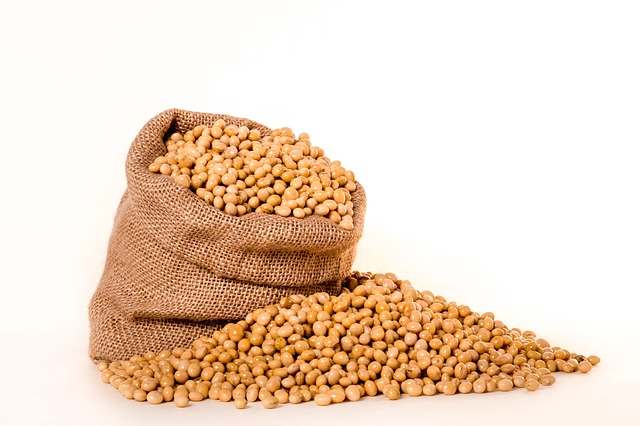Soybean is a crop that has great potential as a source of inexpensive protein in human diets and much valuable use.
It is a fairly new crop in West Africa and has not been quite incorporated into the traditional foods of the people.
Research efforts on the crop have been limited due to the rapid loss of seed viability in the warm moist storage conditions so common on African farms and its poor nodulating ability, as the strain of rhizobium required for nitrogen fixation is specific to the legumes.
An estimated 80,000 hectares of soybeans are cultivated annually in Nigeria, most of this being in Benue State.
Soybean Origin
China is the center of origin of soybeans. It was introduced into Europe in the seventeenth century and reached the united states of America in 1804.
Soybean was introduced into most tropical countries during the twentieth century but attempts to extend the cultivation of the crop in Africa are very recent.
It is grown mainly in the USA., Brazil, China, and Argentina which together grow over 90% of the world’s total production.
Ecology
It is a warm-season subtropical crop which can withstand short periods of drought. Temperatures of 20-25°C appear to be optimum.
The plants are very sensitive to photoperiod; they are short-day plants and most cultivars only bloom when the day length is less than 14 hours but very short days (12 hours and less) lead to premature flowering.
The plants do not tolerate shading and excessive cloudy weather as they need high light intensity for vigorous growth.
Soyabean can grow in a wide range of soil types but thrive best on sandy or clay loams and alluvial soils for good structure and high fertility. The optimum pH ranges from 6-6.5. A rainfall of 500-750mm is necessary for good yields.
Botany
Soybean is an erect bushy herbaceous annual legume, which grows from 20-120cm tall with hairs on all parts.
Two types of growth occur:
cultivars with determinate growth in which the terminal bud develops into a terminal inflorescence;
cultivars with indeterminate growth in which the stem does not terminate in an inflorescence.
Early maturing cultivars are usually indeterminate. The roots consist of a deep taproot with many laterals; most possess nodules, which are small and spherical but sometimes lobed.
The strain of Rhizobium japonicum, the nitrogen-fixing bacteria in the root nodules, is specific to the soybean. Hence if nodules are absent or ineffective, the crop is exhaustive of soil nitrogen.
The leaves are trifoliate with long petioles and arranged alternatively on the stem.
The flowers are white or purple and are carried in bunches in leaf axils; they are borne on short stalks.
In the cultivars with determinate growth, flowers also develop from the terminal bud of the shoot.
The plants are predominantly self-pollinating but some cross-pollination by insects occurs.
The pods are borne in clusters on short stalks, straight or slightly curved, hairy, pale yellow or brown when mature.
They contain 1-5 seeds but different sizes and colors; round to elliptical. The color of the seeds is straw yellow, greenish-yellow, green, brown, or black.
Cultivars
Many exotic lines have shown great promise, among which are improved Pelican and Bossier varieties, Some improved disease and pest-resistant cultivars include TGx996-26E and TGx995-22E.
Cultural practices
Sowing is carried out when rains are well established from May to July.
In the south of Nigeria for example, where the rainy season is long enough to allow for two crops, the first (early) planting should take place in May and the second (late) in mid to end of August.
A seed rate of 75-100kg/ha is required depending on the plant spacing.
Planting is at 60cmx15cm; spacing between rows of 20-30cm and within the row of 10-15cm on the flat gives better yields in the tropics.
Nitrogen fertilizer is rarely required for successful production as soybean plants fix atmospheric nitrogen if the right strain of Rhizobium bacteria is present in the soil.
The application of 40-50 P2O5/ha and 60-70 kg K2O/ha may be adequate for good growth.
Where soil tests give total N values below 0.05%, the application of a starter dose of 20kg/ha N may be necessary.
All fertilizers, including N (if used), should be broadcast and incorporated before planting or placed at least 8cm away from the row of seeds at planting or immediately after germination.
Weeds can be controlled manually by weeding twice at the 3rd and 7th weeks.
Pre-emergence herbicides can also be used to control weeds; e.g gales at 2.5kg a.I/ha or metolachlor + maroquin at 1.5+0.2kg a.I/ha.
Harvesting
Soybean matures in 80-130 days depending on the cultivars. Harvesting should be done before the pods shatter though there are non-shattering types.
Harvesting can be done by hand or with combined harvester. The plants are either cut at ground level or pulled from the ground.
Harvested materials are sun-dried and then threshed. The seeds should be stored at a moisture content of 10-12% or less.
Yields
The average yield of threshed grain is about 1800kg/ha but with good management, the yield of 2500 kg/ha can be obtained. The potential yield is about 5000 kg/ha, especially under research conditions.
Storage
The seeds are stored at a moisture content of 10-12%.
Chemical composition
The seeds contain 5-10% water, 16-25% oil, 30-50% crude protein, 13.5-24.2% fat, 14-24% carbohydrate, 2.8-6.3% fiber, and 3.3-6.4% ash. The seeds contain appreciable quantities of the vitamin B complex.
Uses
1. It is an important source of oil and high-quality protein for human consumption.
It contains all the essential amino acids required by man.
The bulk of the oil is used for the production of margarine, vegetable cooking oil, and salad oil.
Soyabean oil is also used industrially for the manufacture of paints, linoleum, oilcloth, printing inks, soaps, insecticides, and disinfectants.
2. Soybean flour is used in the bakery; flour may be mixed with wheat flour (up to 20% soya flour) to produce a wide variety of baked products. It is also used for making candies and ice cream.
3. The seeds are processed to give soya milk, which is a valuable protein supplement in infant feeding.
4. Soya meal, the residue after the extraction of the oil is a very rich protein feeding stuff for livestock.
5. Used as pasture and fodder crops; green Manuel and cover crops.
Diseases
Diseases that affect soybean include bacterial blight caused by Pseudomonas glycine, bacterial pustules caused by Xanthomonas phaseoli, pod stem blight caused by Diaporthe phaseolus, soybean mosaic virus.
Insect pests
Insect pests of soybean include foliage beetles, leaf hoppers (Empoasca_Spp), armyworms (Spodoptera Spp), cowpea pod borer (Maruca textualism), Cydia moth (Cydia ptychora), the black bug (Riptortus dentipes) and the green stink bug (Nezara viridual).
Control is by use of insecticides, handpicking, and use of natural enemies of the insect pests.










